Homeschool Classroom Ideas
As a parent, you always have your child’s education on top of your priority list.
While there are a plethora of educational institutions and schools that provide your children with the tools for academic excellence there may be a handful that often accounts for their requirements.
Children are always on the move and often go on expeditions to search for new and unique stimuli.
It is a parent’s responsibility to provide their child with a resourceful, nurturing, and appropriate environment that allows children to thrive even when they are in the comfort of their homes.
While Traditional Educational Institutions appear to be the easy way out, most parents in the contemporary world are opting for a more hands-on educational approach that caters to their child’s age-appropriate individualistic requirements.
Homeschooling has become a popular trend amongst a wide range of parents who prefer to be vigilant and attentive to what is being taught to their children.
While the concept or approach of homeschooling seems to be direct and simple, incorporating appropriate educational materials in the home environment is a requisite.
Here are some fun and exciting Homeschool Classroom Ideas that will cater to your child’s requirements and promote holistic education.
Contents
What is Homeschooling Exactly?
Homeschooling is a contemporary progressive movement that eliminates the requirement of sending children to traditional educational institutions.
Homeschooling can be regarded as an innovative alternative educational approach to please parents who are often dissatisfied with traditional educational structures and curricula.
Homeschooling essentially is an educational environment where parents possess the role of educators and develop an appropriate home environment that acts as an efficient alternative to traditional schools.
There is a wide range of reasons why several parents resort to Homeschooling for their children ranging from limitations, rigidity, opposing religious approaches, and a lack of progressiveness possessed by traditional means of education.
What are the Characteristics of a Successful Homeschool Environment?
The key to any successful educational philosophy is not only limited to its curriculum and educational methodology.
Appropriate stimuli, educators’ responsibilities, and the educational environment equally contribute to the child’s development process.
To create an appropriate homeschool classroom environment, parents have to recognize and comprehend characteristics that are essential for developing a homeschool classroom for their child.
To create a sustaining, nurturing, and successful here is a list of characteristics parents should refer to:
1) Organized:
Regardless of the educational sanctuary residing in your home, your child should always associate their educational space as organized and systematic.
It is a parent’s responsibility to systematically organize their child’s homeschool classroom.
A successful Homeschool Classroom should have designated areas, shelves, and drawers to accommodate the child’s educational materials as well as equipment.
2) Educators Behavior:
While inculcating values of order and system is important to create an appropriate bond between the educator and pupil.
As a parent who is adopting the homeschool philosophy, you must at all times treat the child with mutual respect and be enthusiastic towards their learning process.
Children for the initial six years are beginning to establish new relationships and often ask a plethora of questions to enhance their knowledge of the world.
Parents consuming the part of an educator must always be kind and patient when repeatedly asked questions.
Parents should always clear their child’s doubts to build a firmer foundation and enhance the child’s educational process.
3) Flexibility:
While Traditional Educational Institutions limit the child’s learning experience to a rigid work cycle, Homeschooling provides children with a more flexible educational schedule.
Rigidity may seem to be a way of introducing the child to the world of system and order, but it usually limits the child’s development process. Furthermore, a time constraint can also agitate the developing toddler.
Parents and children can develop their own educational work cycle based on the child’s individualistic requirements.
4) Discipline:
Homeschooling is not about doing as you please, while establishing this educational approach parents should be vigilant and attentive.
While flexibility in terms of curriculum and work cycle is an integral aspect of homeschooling, inculcating values of discipline is equally as important.
Parents must establish rules and regulations that help children develop inner discipline and respect towards their environment as well as peers.
5) Engaging and Entertaining:
Maintaining a successful homeschool environment can be difficult when educational lessons become monotonous.
Children are always in search of new and exciting stimuli, parents must incorporate engaging stimuli that allow the child to develop new skills.
The lesson that is to be taught should ways be delivered in an exciting manner in order to keep the child entertained and engaged for hours on end.
It is the parent’s responsibility to iterate unique learning equipment that helps children develop.
Incorporating educational Materials and aids can help parents deliver successful lessons and establish a homeschool environment that develops along with the child.
6) Close to No Distractions:
Children are easily distracted by vivid toys or objects that fashion manipulative components.
Parents should avoid incorporating toys or materials that may overwhelm and overstimulate the child.
Elimination of unnecessary stimuli helps children engage or play with appropriate materials that aid their development.
It is best to avoid integrating modern technological appliances that may obstruct and hinder the child’s educational progress.
What are the Prerequisites of Homeschooling?
Homeschooling is a unique educational approach that allows parents to take control of their child’s academic development and prospects.
While traditional educational institutions either privatized or public, are legally licensed to provide children with educational aid.
Homeschooling is no different from such institutions, to establish a successful educational environment at home legal recognition is integral.
While the process of standardization and recognition varies from place to place, there may be some states in the U.S. that may have close to no legal requirements.
The other States often ask for an educational portfolio, and reviews, and often run standardized tests to analyze whether parents are equipped to educate their children.
How to Set up a Successful Homeschool Classroom?
Upon taking the characteristics of an appropriate homeschool environment into account, parents can effectively prepare an educational environment at home that facilitates holistic development.
Here are some tips and tricks to follow when preparing a homeschool classroom for your child:
1. Desks and Chairs:
A quintessential classroom setup always incorporates a desk and chair. Parents must provide their children with child-sized desks and a chair that acts as an aid for their child’s educational experience.
The desk and the chair must always be:
- child-sized to be easily accessible
- durable to promote longevity
- Sturdy to enhance the child’s writing experience
- Comfortable promoting good posture
2. Writing Board:
Whiteboards are a requisite for any classroom regardless of the location. A homeschool Classroom should always have a whiteboard or a blackboard.
White Boards and Blackboards help parents efficiently deliver lessons and lectures to the child.
Furthermore, these illustrations can help children comprehend educational concepts much faster.
3. Wallspace:
It is important to take into consideration that your Homeschool Classroom will require plenty of wall space to place educational equipment or aids.
Whether the wall fashion a bulletin board, posters, or Whiteboard you must leave adequate space on the wall.
4. Storage space:
Storage space is essential for accommodating educational apparatus, materials, and tools.
Parents must leave room or space in their homeschool classroom for shelves, buckets, bins, and organizers that will contain educational materials.
5. Shelves:
Shelves are integral for displaying your child’s academic successes, books, notebooks, and other educational materials that are to be immediately used.
Parents must incorporate child-sized shelves that are easily accessible and study to avoid any accidents.
6. Materials and aids:
Whether it is writing equipment, scissors, scales, notebooks, staplers, colors, or glitter glue parents must provide their children with age-appropriate school supplies.
7. Board:
To give your Homeschool Classroom a touch of personalization, Parents can incorporate a Bulletin board.
Bulletin boards are beneficial for representing the educational schedule, fashioning the child’s achievements, and indicating the potential educational agenda.
Top 10 Homeschool Classroom Ideas
After taking the basic requirements of the Homeschool Classroom into consideration, parents can prepare their homeschool classrooms with a personal touch.
Here are some intriguing and unique Homeschool Classroom Ideas that will allow your child to thrive and encourage them to become seekers of knowledge.
1) Color-coded:
Color coding can be a fun and aesthetic way of organizing your homeschool classroom.
Parents can pick out colored organizers that are designated for specific tools and materials.
Colored-coded and labeled containers can help children easily filter through the shelves and choose the required materials.
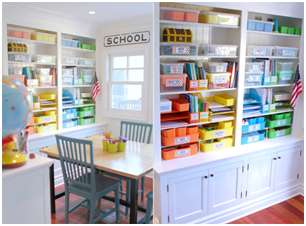
2) Homeschool Classroom for Smaller Spaces:
Have trouble finding enough room for your homeschool classroom?
Who says Homeschool Classrooms require large spaces when you can create a teaching nook for your tiny learner?
Find yourself a nice spot that adequately accommodates all your child’s educational essentials and set up a classroom.
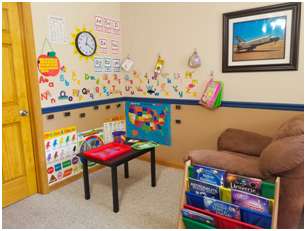
3) The Creativity Hub:
Who says education is limited to books and traditional curriculum when you can enhance your child’s educational progress with a creativity corner?
Promote holistic, gross motor, and fine motor development with the help of this exciting homeschool classroom.
Incorporate several art and crafts tools, materials, and apparatus to help your child take the free reign of their imagination.
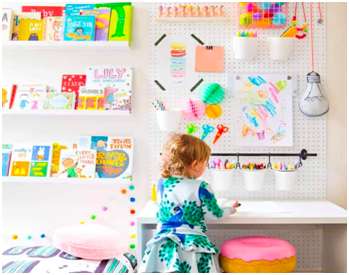
4) Minimalistic Classroom:
A classroom adorned with vibrant decorations and several toys can often become distracting for the child.
Parents can opt for using minimal classroom furniture and decoration to eliminate any distracting stimuli.
Parents can incorporate only the requisite materials and provide only the important materials or lessons that aid the child’s immediate needs.
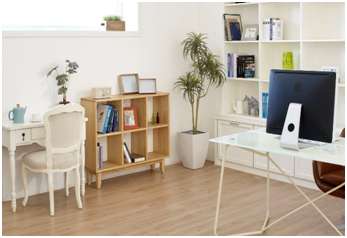
5) Art Galore:
What better way to encourage your child to learn than by celebrating their progress and achievements?
Positive affirmation and appreciation help boost your younger one’s confidence and promote them to work harder in order to achieve higher attainments.
One simple way to enhance your child’s educational experience is by setting up a board that fashions all their unique artwork.
Parents can use a bulletin board with colorful decorations to provide a more aesthetic appeal.
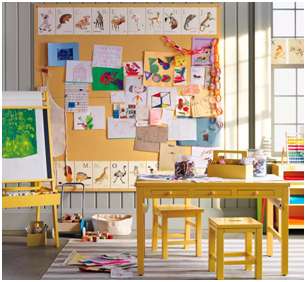
6) Activity Center:
If you are a parent you know, the best way to keep your child busy is by allowing them to participate in simple activities.
Parents can promote their children to willingly indulge in purposeful, insightful, and educational activities that promote academic development as well as promotes the enhancement of fine motor and gross motor skills.
Parents can incorporate exciting and child-friendly arts and crafts supplies to prepare this Homeschool Classroom.
Parents can also integrate several educational toys that provide children with valuable lessons as well as promote fine motor development in children.
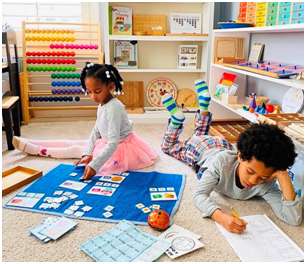
7) Montessori Inspired:
The Montessori Method of education is a unique pedagogical tool that allows children to indulge in auto-didactic education and hands-on learning.
If you are a parent who wants to successfully incorporate the Montessori philosophy into your child’s environment to create a Homeschool Classroom, use Montessori-inspired shelves, containers, and decor.
The Montessori Prepared environment assimilates minimalist and sophisticated furniture and toys to avoid overstimulation and overwhelming the child.
Parents can integrate wooden Montessori toys and Montessori Materials to enhance the child’s educational experience.
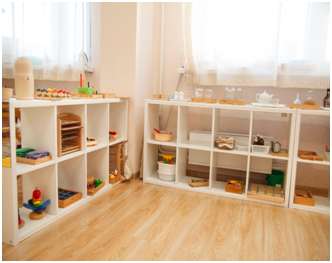
8) Sibling Workspace:
Are you having trouble accommodating all the siblings in a cramped-up classroom? Well here’s a solution for you!
Parents you use wall-mounted tables with separate bulletin boards, chairs, school supplies, and stationery for the siblings.
Parents can also incorporate fun and exciting name boards to assign desks and chairs to the siblings.
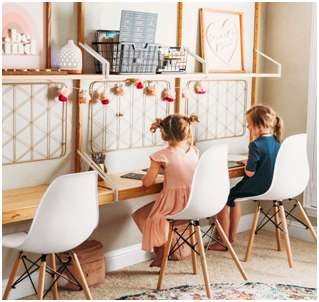
9) Chalkboard wall:
What better way to promote insightful and engaging educational activities, than by creating a chalkboard wall.
Parents can paint a segment of a wall or an entire wall of their child’s Homeschool Classroom to enhance the child’s learning process.
This chalkboard can be used for delivering illustrative lectures, promoting children to practice writing, and as a fun and engaging activity.
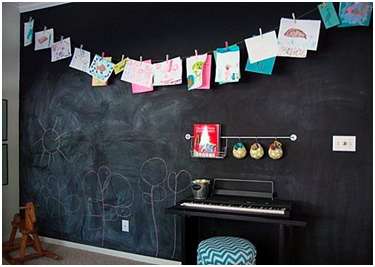
10) Modern and chic:
If you are a parent who wants your child to be in sync with the contemporary world, this Homeschool Classroom idea is meant for you.
For a more modernistic approach to your Homeschool Classroom Derocration and furniture, you can use monotone colors, invisible plastic chairs, an abacus, and other educational toys.
Minimal decoration will help eliminate distracting stimuli that can overwhelm the child and overstimulate their sense.
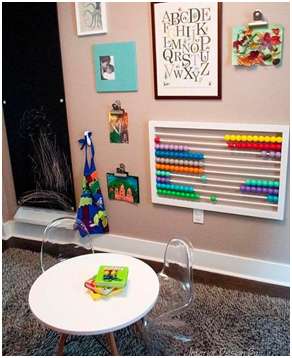
Should you set up a Homeschool Classroom for your child?
The answer to whether or not homeschooling is right for your child is subjective as it is based on the developmental needs and requirements of your child.
The homeschooling environment is great for parents who would like to take complete reign over their child’s educational process.
Unlike traditional educational institutions, homeschooling provides the child with the freedom of choice and provides them with ample opportunities to achieve academic excellence.
If you are a parent who wants to incorporate an educational approach that allows your child to work at their own pace and promotes physical as well as emotional safety, homeschooling may be the best approach for your child!
See Also: